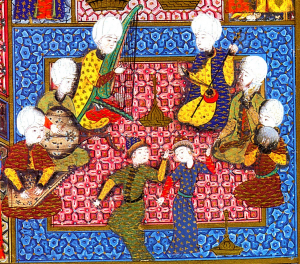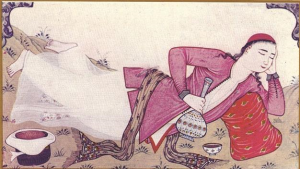(Boylove Documentary Sourcebook) - The Prevalence of Pederasty in the Early 17th-Century Ottoman Imperial Court, as Depicted in 'The History of the Serrail, and of the Court of the Grand Seigneur, Emperour of the Turkes' by Michel Baudier

From The History of the Serrail, and of the Court of the Grand Seigneur, Emperour of the Turkes (Histoire generalle du Serrail, et de la Cour du Grand Seigneur Empereur des Turcs [1624], Second Edition [1631]) by Michel Baudier, translated out of French by Edward Grimeston, in The History of the Imperiall Estate of the Grand Seigneurs (London: William Stansby for Richard Meighen, 1635).
That which we have formerly written of the entertainment of the Turkish Prince with his women, is not the most blameable of his affections. The greatnesse of his power, which makes all mens wils obey him, and the contagious example of his Courtiers, carries him to the detestable excesse of an unnaturall passion. Hee burnes many times for the love of men, and the youngest Boyes which are in the Levant, the flowre of beautie and the allurement of graces, are destinated to the filthinesse of his abominable pleasures. The Bashaes bring them from the remote Provinces, and present them unto him. This disorder is so inveterate in the Serrail, as of twenty Emperours which have carried the Turkish Scepter, you shall hardly find two that were free from this vice. Achmat the last which died, abandoned it a little before his death, by the wise advice of the Mufti, and his Sonne Amurath the Fourth who raignes at this present 1626. is yet so young, as hee may be easily diverted from this excesse, and framed to vertue, eschewing the Rockes, where his Predecessours have suffered shipwracke.
[...]
The great fortunes which are found in the Courts of great Monarches, produce great riches: and these furnish Courtiers with delights, in the which they glut their sensuall and brutish appetites. The Bassa’s of the Court, great in diginities and abounding in riches, plunge themselves in all sorts of voluptuousnesse, and their spirits mollified in the myre of filthy pleasures, they seeke them by a contrary course, and demand that of nature which she hath not: Being many times tired with the love of women, they abandon their affections to young Boyes, and desperatly follow the allurements of their beauties: They imbrace them, and use them in the place of women. This abhominable vice is so ordinary in the Turks Court, as yee shall hardly find one Bassa that is not miserably inclined unto it: It serves for an ordinary subject of entertainment among the greatest when they are together; they speake not but of the perfections of their Ganimedes: One sayes, they have brought me from Hungarie the most beautifull and accomplished Minion, that ever was borne among men: he is the height of my felicitie, and the only object that my thoughts adore. Another saith, I have lately bought a young Infant of Russia, who hath not his like in all the East, and I dare assure you his countenance is not humane, but that of an Angell: Some Sot of the company intreats him earnestly to have a fight, and that hee may bee satisfied by his eyes. These are the discourses of those lustfull Goats. The care they have to keepe neatly, and to attire richly these poore creatures, destinated to so damnable an use is not small: the Eunuches which have them in guard are alwayes neere them, to beautifie them outwardly, they plaite their haire with Gold, and sometimes with Pearles, they perfume them, they attire them in Robes of Cloth of Gold, and adde to their naturall beauty whatsoever Arte can invent: what vertue, what wisdome, what pietie can be found in a Court composed of such men?

See also
- Adult friend (dictionary)
- Age of attraction (dictionary)
- Boylove
- Ephebophilia
- Ghilman
- Loved boy (dictionary)
- Minor-attracted person (dictionary)
- Pederasty in the Middle East and Central Asia
- Pedophilia
- Situational homosexuality (dictionary)
- Sufism
- Tellak
- Young friend (dictionary)
External links
- The history of the imperiall estate of the grand seigneurs their habitations, liues, titles ... gouernment and tyranny. Translated out of French by E.G. S.A. (Early English Books Online - Text Creation Partnership)
- THE HISTORY OF THE SERRAIL, AND OF THE COURT OF THE GRAND SEIGNEUR, EMPEROUR OF THE TURKES BY MICHEL BAUDIER, 1709 (Greek Love Through the Ages)
- THE AGE OF THE LOVED BOY IN THE ARAB-ISLAMIC WORLD, 1500-1800 (Greek Love Through the Ages)